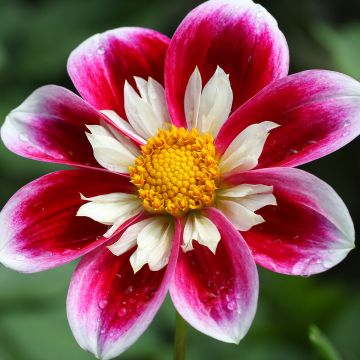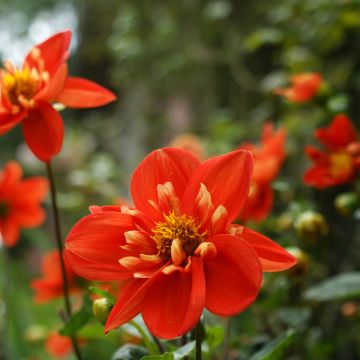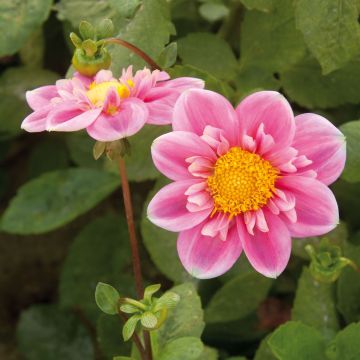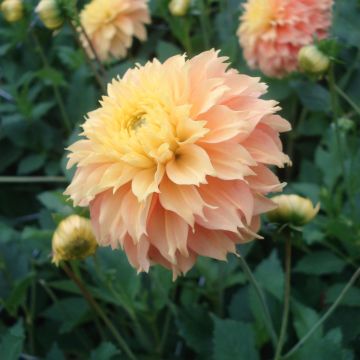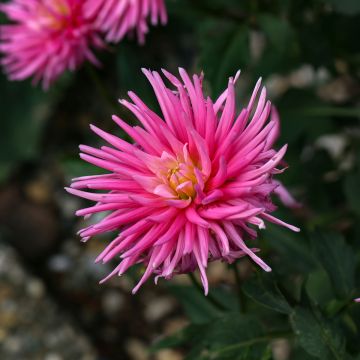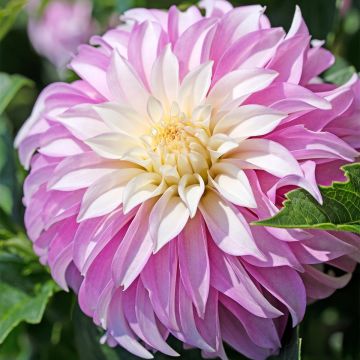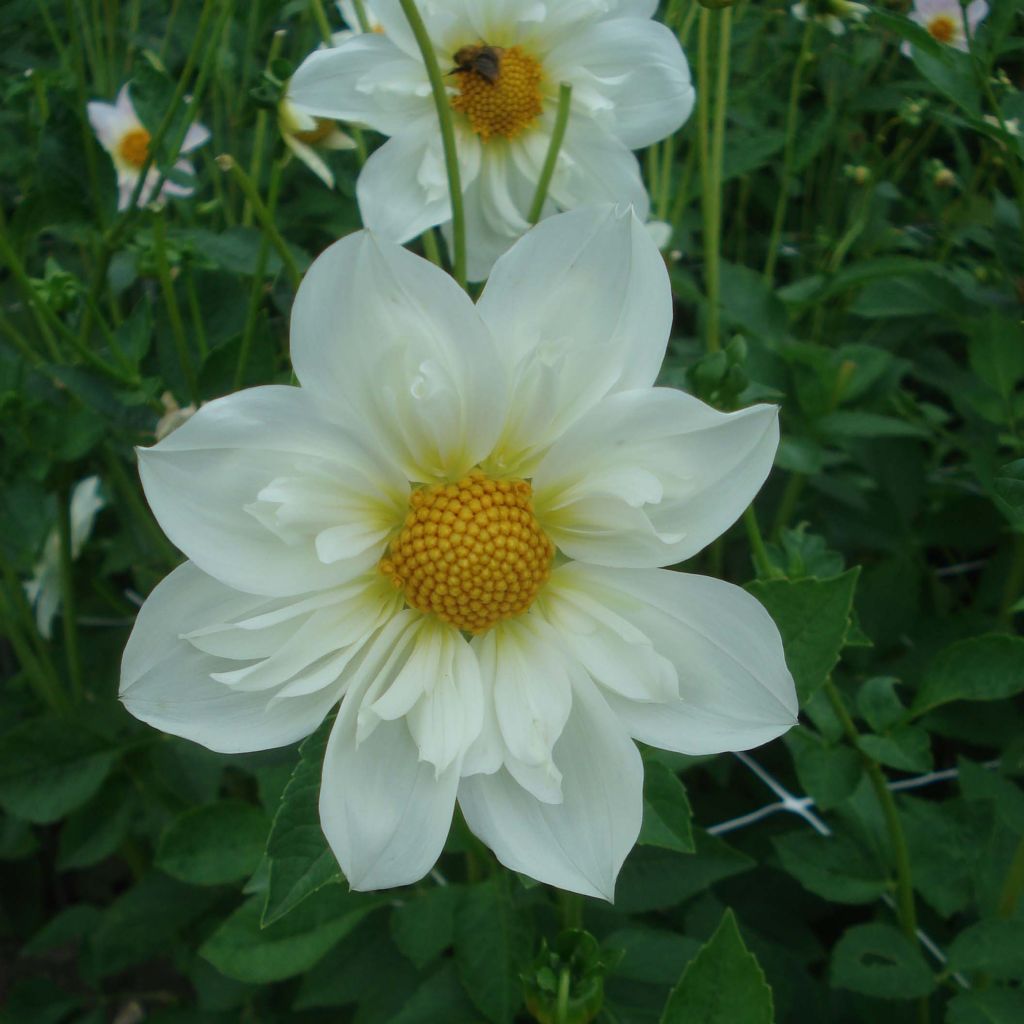

Dahlia collerette Twyning's White Chocolate
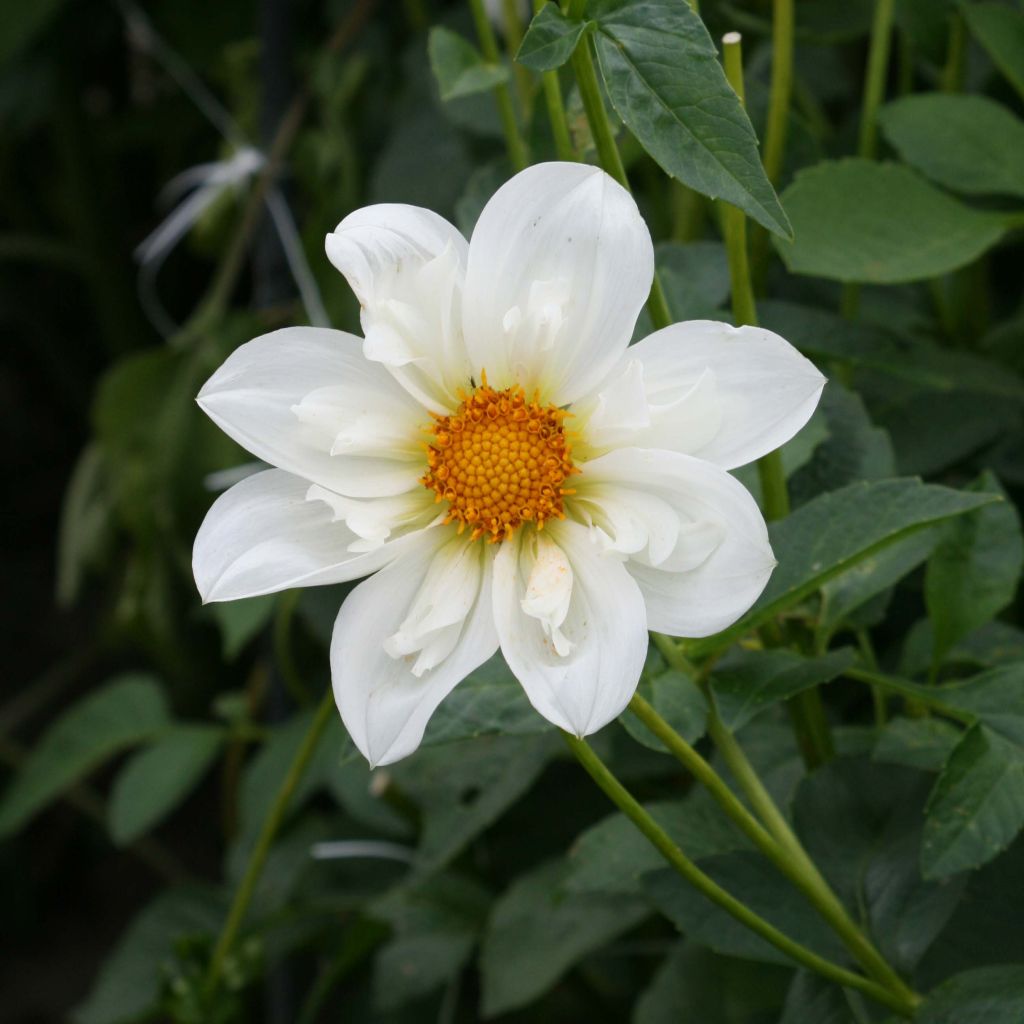

Dahlia collerette Twyning's White Chocolate


Dahlia collerette Twyning's White Chocolate
Dahlia Twyning's White Chocolate
Dahlia Twyning's White Chocolate
Dahlia
The plant has grown very poorly, it is tiny, and I have no flowers. Response from Promesse de Fleurs. I apologize for this inconvenience, but the summer weather has not been favorable for the proper development of dahlias. Best regards.
Stéphanie, 08/09/2021
Why not try an alternative variety in stock?
View all →This plant carries a 6 months recovery warranty
More information
We guarantee the quality of our plants for a full growing cycle, and will replace at our expense any plant that fails to recover under normal climatic and planting conditions.
From €5.90 for pickup delivery and €6.90 for home delivery
Express home delivery from €8.90.
Does this plant fit my garden?
Set up your Plantfit profile →
Description
The Dahlia 'Twyning's White Chocolate' possesses all the charm of Collarette Dahlias, highly appreciated for their trim of tiny petals delicately highlighting the heart of the flower. This one is pure white, with wide petals and immaculate collar opening up to a beautiful orange heart finely circled in yellow. It blooms all summer on a very beautiful bushy plant adorned with medium green foliage. This variety, easy-to-combine with all the flowers in the garden, is simply sensational in a white garden, in the company of tall grasses, asters, penstemons.
Dahlias belong to the asteraceae family and are originally from the high plateaus of Mexico. At present, the some 25,000 horticultural varieties obtained by humans have invaded, much to our delight, gardens all over the world. The variety 'Twyning's White Chocolate', introduced in England in 2006, is a Dahlia classified among Collarette Dahlias, which is a horticultural category defined by the shape of the flower. In this group, the coloured ligules of the head (what we generally call the flower but actually conatins many small flowers) are regularly arranged in a crown around a collar of tiny petals surrounding the central disc. The flowers of 'Twyning's White Chocolate', measuring 12 cm (5in) wide, show outer ligules of pure white, and those in the centre are also white but touched with yellow at the base. The almost orange heart of the flower makes it even brighter. The flowering takes place from July to October, on abundant foliage. The habit is bushy and dense, with the plant reaching about 1 m (3ft) in height and 60 cm (24in) in width in one season. The very branching stems are hollow and the leaves are opposite, pinnately divided into 3 or 5 very toothed lobes. The leaves and stems are medium green.
To encourage repeat flowering, take care to remove faded flowers, or better yet, regularly make large colourful bouquets by combining it with other varieties. 'Twyning's White Chocolate', with its white flowers, goes well with all the flowers in the garden. It has its place in a white garden or a romantic border. This Dahlia will create bright spots in perennial borders or in front of taller shrubs. It can be mixed with tall grasses (Miscanthus, Panicum, Deschampsia cespitosa etc.), Rudbeckia, Salvias, Echinaceas, Cosmos, Baptisia (Baptisia australis 'Alba') that bloom at the same time. It will also harmonise well with Daylilies or Asters.
As a star plant in borders and cottage gardens, Dahlias confidently accompany the most beautiful flowers but are also appreciated alongside vegetable plants. In Mexico, this tuber was initially cultivated as a root vegetable for consumption. However, its poor taste assigned it the status of an ornamental plant. Since then, the interest in their beautiful exuberance has never waned.
Report an error about the product description
Dahlia Twyning's White Chocolate in pictures
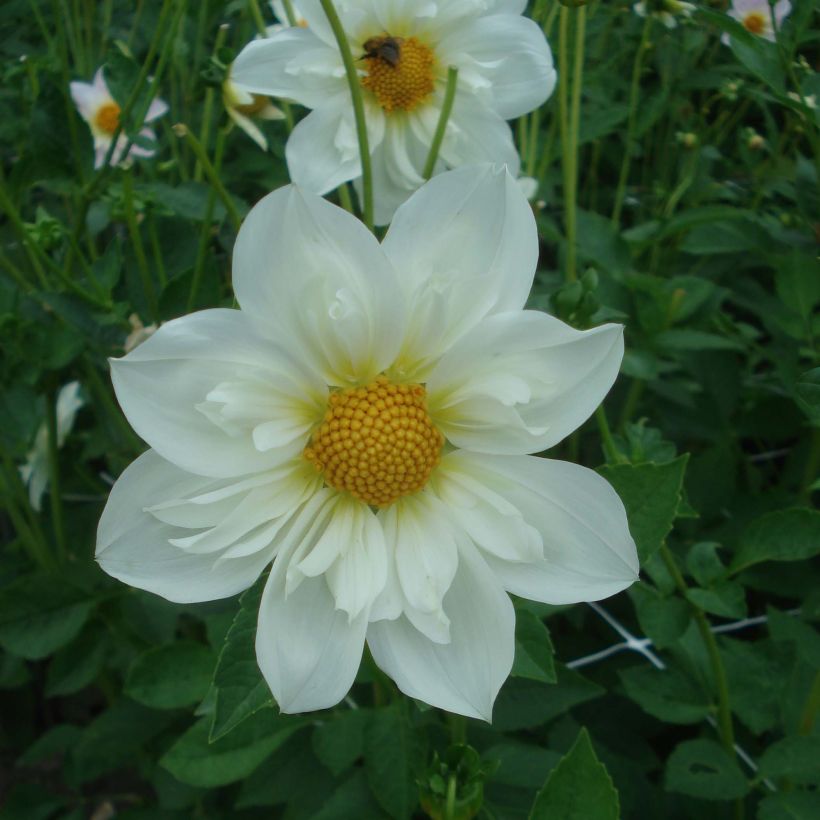

Plant habit
Flowering
Foliage
Botanical data
Dahlia
Twyning's White Chocolate
Asteraceae
Dahlia
Cultivar or hybrid
Other Collarette Dahlia
Planting and care
The 'Twyning's White Chocolate' Collarette Dahlia is easy to grow in all regions. For abundant flowering, it is good to follow a few simple rules, plant the tubers in a sunny location as soon as the last frost has passed, rich, fresh, and well-drained soils are perfect. However, stagnant moisture would promote tuber rot. Feel free to amend the soil with compost and sand if necessary. Work the soil deeply and enrich it, for example, with crushed horn or dehydrated blood. Place your tuber and crumble the soil well to fill the hole without air pockets. Your dahlia should be covered with about 6 cm (2in) of soil. At the end of planting, water abundantly once and then regularly for the first 6 weeks to help with rooting.
Dahlias are sensitive to cold, they need to be overwintered under shelter. In November, the first frosts blacken the foliage, so it is time to dig them up. Carefully unearth the tubers. Remove as much soil as possible. Let the foliage dry so that the tubers can replenish their reserves. Then cut the stems down to 10 cm (4in). Spread your bulbs in a crate on newspaper. Store them protected from frost in a dry, cool, and dark place, such as a frost-free garage or an attic. In the southern regions, close to the coast, where there are few frosty days per year, it is possible to leave them in place. In this case, simply cover the ground with a layer of leaves or straw for protection.
Planting period
Intended location
Care
-
, onOrder confirmed
Reply from on Promesse de fleurs
Dahlias
Haven't found what you were looking for?
Hardiness is the lowest winter temperature a plant can endure without suffering serious damage or even dying. However, hardiness is affected by location (a sheltered area, such as a patio), protection (winter cover) and soil type (hardiness is improved by well-drained soil).

Photo Sharing Terms & Conditions
In order to encourage gardeners to interact and share their experiences, Promesse de fleurs offers various media enabling content to be uploaded onto its Site - in particular via the ‘Photo sharing’ module.
The User agrees to refrain from:
- Posting any content that is illegal, prejudicial, insulting, racist, inciteful to hatred, revisionist, contrary to public decency, that infringes on privacy or on the privacy rights of third parties, in particular the publicity rights of persons and goods, intellectual property rights, or the right to privacy.
- Submitting content on behalf of a third party;
- Impersonate the identity of a third party and/or publish any personal information about a third party;
In general, the User undertakes to refrain from any unethical behaviour.
All Content (in particular text, comments, files, images, photos, videos, creative works, etc.), which may be subject to property or intellectual property rights, image or other private rights, shall remain the property of the User, subject to the limited rights granted by the terms of the licence granted by Promesse de fleurs as stated below. Users are at liberty to publish or not to publish such Content on the Site, notably via the ‘Photo Sharing’ facility, and accept that this Content shall be made public and freely accessible, notably on the Internet.
Users further acknowledge, undertake to have ,and guarantee that they hold all necessary rights and permissions to publish such material on the Site, in particular with regard to the legislation in force pertaining to any privacy, property, intellectual property, image, or contractual rights, or rights of any other nature. By publishing such Content on the Site, Users acknowledge accepting full liability as publishers of the Content within the meaning of the law, and grant Promesse de fleurs, free of charge, an inclusive, worldwide licence for the said Content for the entire duration of its publication, including all reproduction, representation, up/downloading, displaying, performing, transmission, and storage rights.
Users also grant permission for their name to be linked to the Content and accept that this link may not always be made available.
By engaging in posting material, Users consent to their Content becoming automatically accessible on the Internet, in particular on other sites and/or blogs and/or web pages of the Promesse de fleurs site, including in particular social pages and the Promesse de fleurs catalogue.
Users may secure the removal of entrusted content free of charge by issuing a simple request via our contact form.
The flowering period indicated on our website applies to countries and regions located in USDA zone 8 (France, the United Kingdom, Ireland, the Netherlands, etc.)
It will vary according to where you live:
- In zones 9 to 10 (Italy, Spain, Greece, etc.), flowering will occur about 2 to 4 weeks earlier.
- In zones 6 to 7 (Germany, Poland, Slovenia, and lower mountainous regions), flowering will be delayed by 2 to 3 weeks.
- In zone 5 (Central Europe, Scandinavia), blooming will be delayed by 3 to 5 weeks.
In temperate climates, pruning of spring-flowering shrubs (forsythia, spireas, etc.) should be done just after flowering.
Pruning of summer-flowering shrubs (Indian Lilac, Perovskia, etc.) can be done in winter or spring.
In cold regions as well as with frost-sensitive plants, avoid pruning too early when severe frosts may still occur.
The planting period indicated on our website applies to countries and regions located in USDA zone 8 (France, United Kingdom, Ireland, Netherlands).
It will vary according to where you live:
- In Mediterranean zones (Marseille, Madrid, Milan, etc.), autumn and winter are the best planting periods.
- In continental zones (Strasbourg, Munich, Vienna, etc.), delay planting by 2 to 3 weeks in spring and bring it forward by 2 to 4 weeks in autumn.
- In mountainous regions (the Alps, Pyrenees, Carpathians, etc.), it is best to plant in late spring (May-June) or late summer (August-September).
The harvesting period indicated on our website applies to countries and regions in USDA zone 8 (France, England, Ireland, the Netherlands).
In colder areas (Scandinavia, Poland, Austria...) fruit and vegetable harvests are likely to be delayed by 3-4 weeks.
In warmer areas (Italy, Spain, Greece, etc.), harvesting will probably take place earlier, depending on weather conditions.
The sowing periods indicated on our website apply to countries and regions within USDA Zone 8 (France, UK, Ireland, Netherlands).
In colder areas (Scandinavia, Poland, Austria...), delay any outdoor sowing by 3-4 weeks, or sow under glass.
In warmer climes (Italy, Spain, Greece, etc.), bring outdoor sowing forward by a few weeks.

































